A Triathlon Journey: My Path to Resilience and Peak Performance – A Metaphor for Scaling Businesses
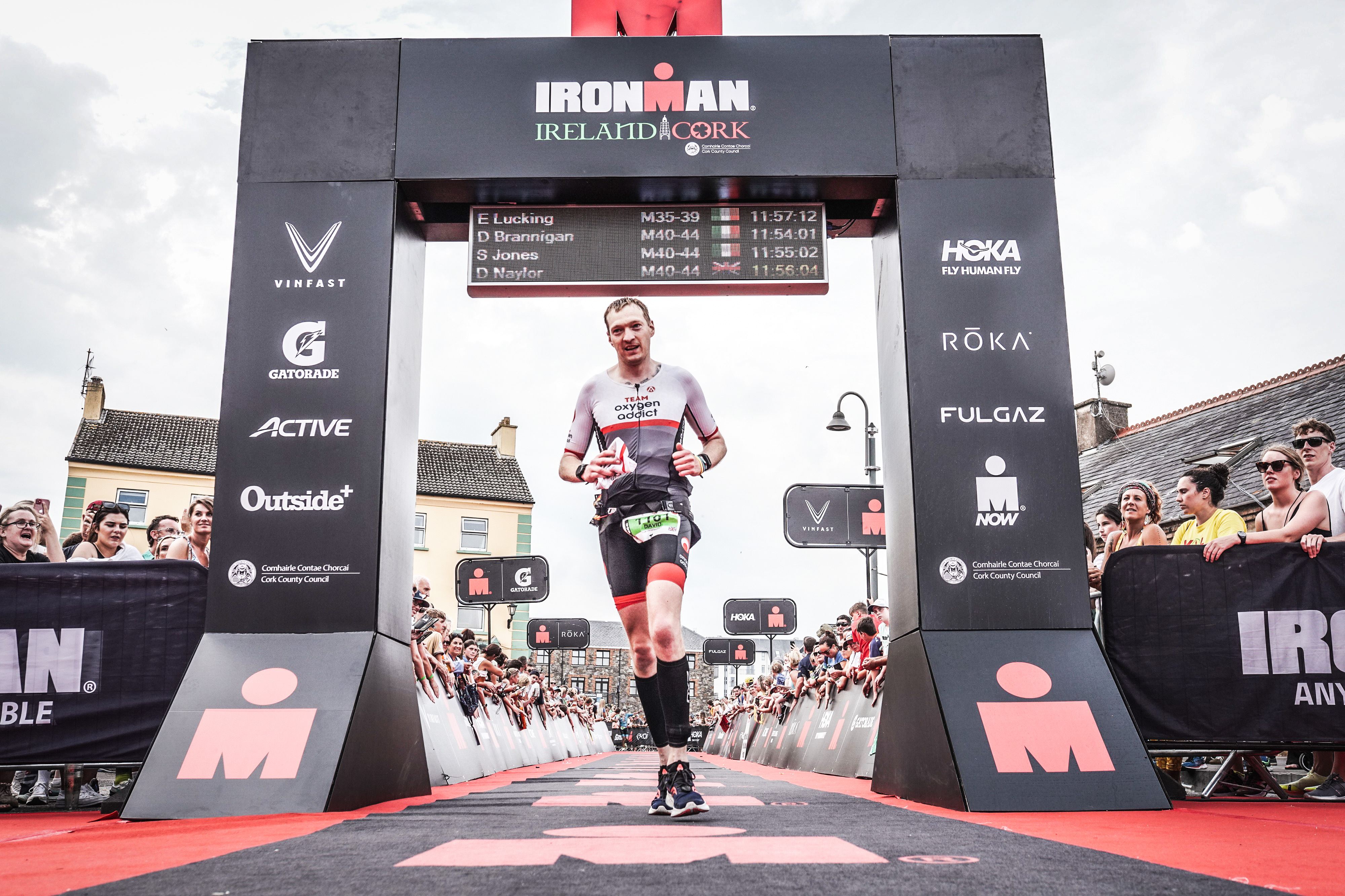
I’ve spent the last few months deeply immersed in launching my technology consultancy, Naylor Technology Limited, pushing my offerings around Fractional CTO and AI Advisory work. But in the background, I’ve also been training extremely hard for two massive challenges inside of three weeks. The first was Challenge Roth last Sunday, 6th of July, and the second is Ironman Leeds on the 27th July. For those that don’t know, a full distance triathlon consists of a 3.8 km swim, a 180 km bike ride, and a marathon.
So, why am I sharing this? Well (and this is the vanity angle), maybe it will inspire some of you to take the first step towards a healthier you. I started from nothing and achieved my goals. And also, because I hope that my journey through long-distance triathlon, with all its physical and mental demands, is a powerful metaphor for the challenges and triumphs we face in the business world, especially when guiding a company through rapid growth or technological transformation. It has profoundly influenced how I approach leadership and problem-solving over the years.
Prefer to listen? Here’s the AI-powered audio version.
As with my last post, I have used Google Notebook LM to analyse the content of this post and break it down into a an audio overview.
Still no UK voices saying things like Ta Love and it’l be reet and they have assumed I have already done Ironman Leeds (that is two weeks away at the time of writing). but other than than its a good break down of the post and something for the car, dog walk or commute.
Some History
I signed up for the 2020 Ironman UK without the ability to swim. I met two guys on a stag trip to Ireland. They had just done it, they were normal blokes and whilst I knew about Ironman (thanks Trans World Sport, Saturday mornings in the 1990’s!), they normalised it for me.
I was searching for something to challenge me, so I entered the 2020 race. Due to covid I had an extra year to train. That was probably a good thing! I did it and I survived, finishing in a respectable 12:46 and I honestly believe it saved my life! More on that later. At this stage, I knew 2 things
- I was hooked!
- I’d found my tribe.
-
For 2022, I still couldn’t swim well but I was getting better, so I signed up for Ironman Cork – notorious for bad swim conditions in the Irish sea, sadly culminating in tragedy when two people lost their lives in the swim in 2023, bringing an end to the running of the event. Training in the sea at Scarborough was a particular highlight for me. I completed Ironman Cork in blistering heat in 11:56.
-
In 2023, I decided a fast European course was in order and entered Ironman Copenhagen. This also became out summer holiday for my long suffering Wife Laura and the girls! Apparently 4 days in the camper van on a Rugby pitch in Ireland the year before needed an upgrade. So a very swanky Air B and B was in order. I had an excellent sea swim in 1:13, down from 1:18 in Ireland and 1:27 in the UK. I was the fittest I’d ever been and riding very well. I was on for a 5:05 bike split before I was knocked off by a car with 10k to go. I jumped up, brushed myself down, looked after the athlete that was stuck to my wheel drafting and so took the bulk of the impact as i served over the hood of the car and carried on. I ended up finishing Copenhagen in 10:56 after a very tough run when my adrenaline wore off.
-
2024 was a year of new jobs, lack of focus, and just having fun with the base fitness I’d built. I did lots of 70.3s – always chasing sub-5 hours, but never quite getting there. Realistically, Laura my wife had put up with a lot of absence through training and a year off the commitment of training for a full was a good thing.
-
2025: Challenge Roth – the bucket list race! For the first time in its 41 year history, Roth was a non wetsuit swim. If you’re a triathlete that isn’t coming from a swimming background you will understand the fear this brings! With work stress and general busyness I didn’t go into Roth in 2023 shape but I was still in ok shape and I completed it in 11:54. Not quite what I wanted, probably what I deserved but still a huge achievement. Having driven there, camped and driven home, to say I was tired last week would be a bit of an understatement! And in less than two weeks, at the end of this month, Ironman Leeds! Why, because it’s on my doorstep, the medal is ace and I couldn’t resist the first race in Leeds!
What is My Why?
That’s a question many people ask when you tell them what you do for fun. And many people struggle to answer it. I think for me there are a few reasons:
- Resilience. To complete these events, you have to have extremely good physical and mental resilience. I took up triathlon at a point in my life where I was as low as I had ever been mentally. I don’t wish the thoughts I had on anyone, but when you’re riding your motorbike to work with a young family at home and you think things like ‘I’d be better off under that bus,’ something needs to give. For me, that was the realisation in 2016 that it was just a job, and no one individual has the right to make you feel like that – act on it, move on and find a new purpose. It took me a few more years to find triathlon and that turbo charged my resilience and recovery.
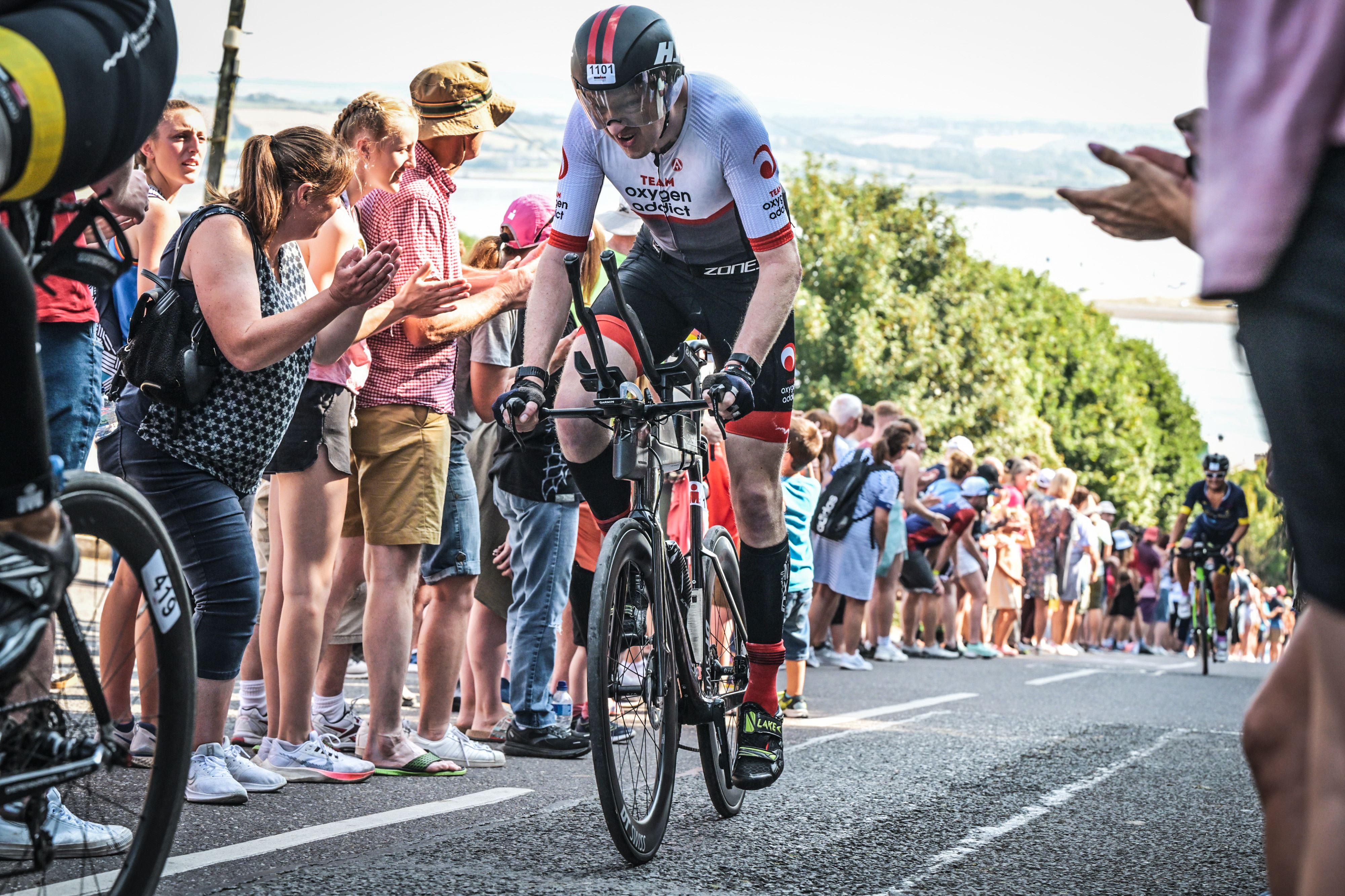
-
I like to do things that stretch my comfort zone. Signing up for an Ironman and then learning to swim. Signing up for races in the sea where all the sharks live 🦈. Signing up for two full distance races within three weeks of each other!
-
Exploring the power of the mind. This gets me back to resilience.
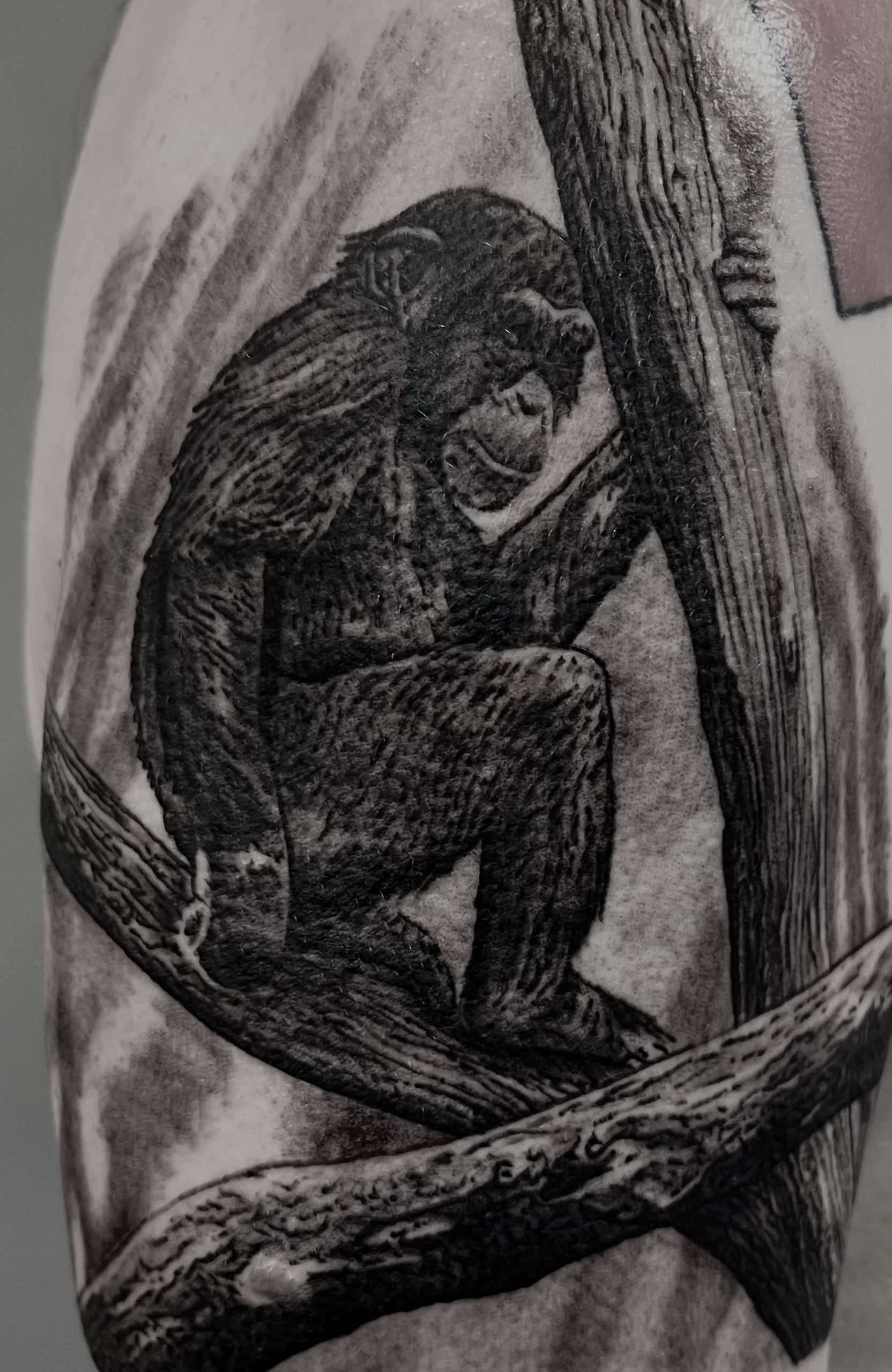 You see this tattoo on my shoulder? This is Barry. Barry is my “chimp,” inspired by the book “The Chimp Paradox,” and he comes everywhere with me. I would say Ironman racing is 40% fuel, 20% fitness and 40% mental strength – this is proven by the people who are brave enough to make the start line. They come in all shapes and sizes. Some take 8 hours to complete it, and others the full 17 – the accomplishment is the same. This is achieved through the mental resilience built by getting up in the middle of winter and getting on it. By having an internal fight about going for that run or that swim, and the chimp in your brain arguing it’s cold, or raining, or swimming feels like drowning (if you’re me). Barry often gets very grumpy during training, and extremely grumpy in races, trying to convince me to stop. But taking him with me means we can have a chat, and ‘rational Dave’ can usually talk him round. Overcoming those thoughts and getting it done is a huge win. When you keep winning, you compound the mental strength gains, and when it hurts on race day, which believe me it does, you go back to those little wins and you remind yourself AND crucially your Chimp that you can keep moving forwards! Think about it: for those that have done running races, that feeling that you get when your body says no more, let’s stop now, this hurts. Then, no matter what, when you’re within sight of the finish line, you speed up. As humans, we are so much more than we have become; we are capable of so much more. We need to remember that and do things that scare us because then we can overcome them!
You see this tattoo on my shoulder? This is Barry. Barry is my “chimp,” inspired by the book “The Chimp Paradox,” and he comes everywhere with me. I would say Ironman racing is 40% fuel, 20% fitness and 40% mental strength – this is proven by the people who are brave enough to make the start line. They come in all shapes and sizes. Some take 8 hours to complete it, and others the full 17 – the accomplishment is the same. This is achieved through the mental resilience built by getting up in the middle of winter and getting on it. By having an internal fight about going for that run or that swim, and the chimp in your brain arguing it’s cold, or raining, or swimming feels like drowning (if you’re me). Barry often gets very grumpy during training, and extremely grumpy in races, trying to convince me to stop. But taking him with me means we can have a chat, and ‘rational Dave’ can usually talk him round. Overcoming those thoughts and getting it done is a huge win. When you keep winning, you compound the mental strength gains, and when it hurts on race day, which believe me it does, you go back to those little wins and you remind yourself AND crucially your Chimp that you can keep moving forwards! Think about it: for those that have done running races, that feeling that you get when your body says no more, let’s stop now, this hurts. Then, no matter what, when you’re within sight of the finish line, you speed up. As humans, we are so much more than we have become; we are capable of so much more. We need to remember that and do things that scare us because then we can overcome them!
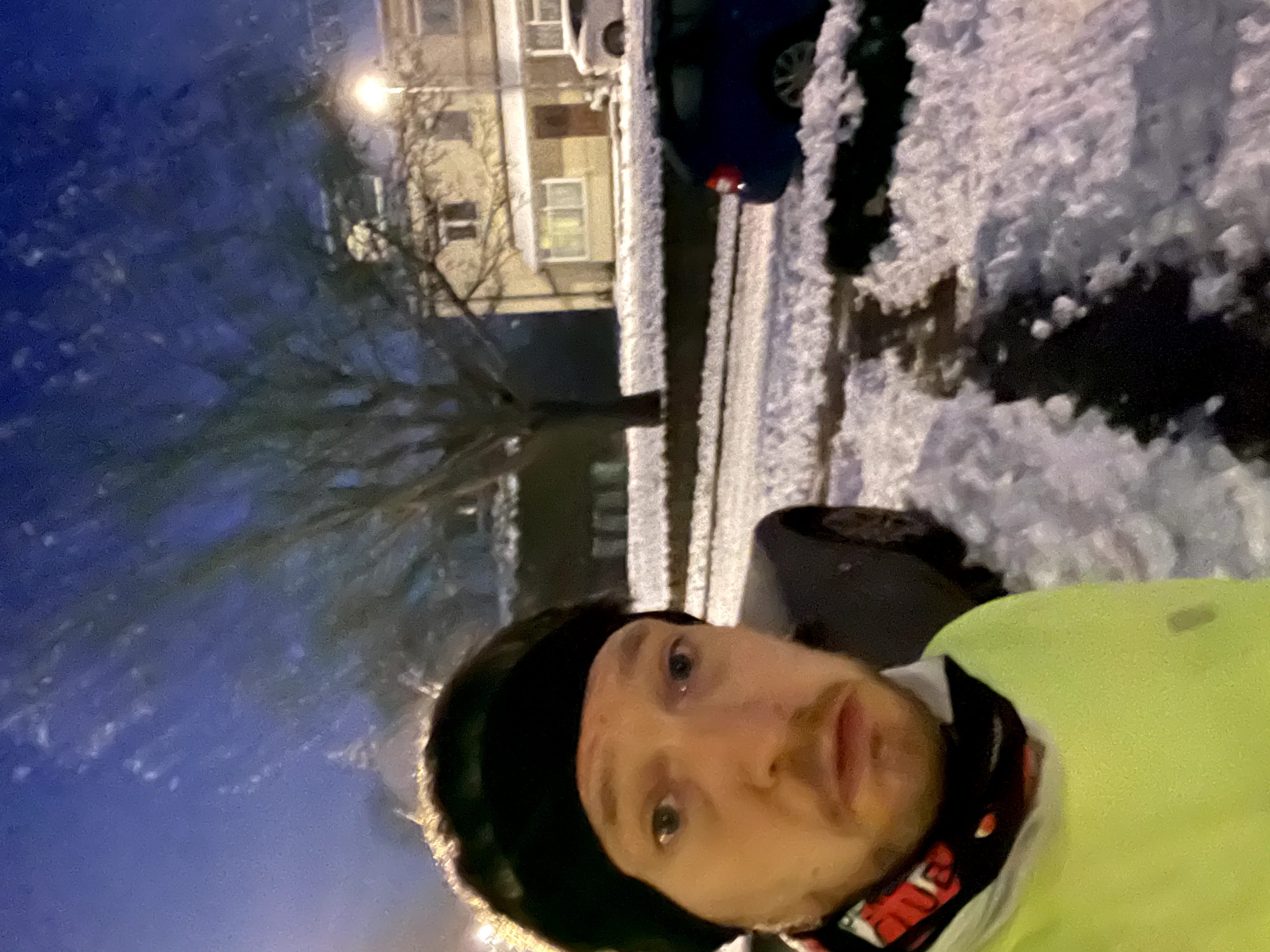
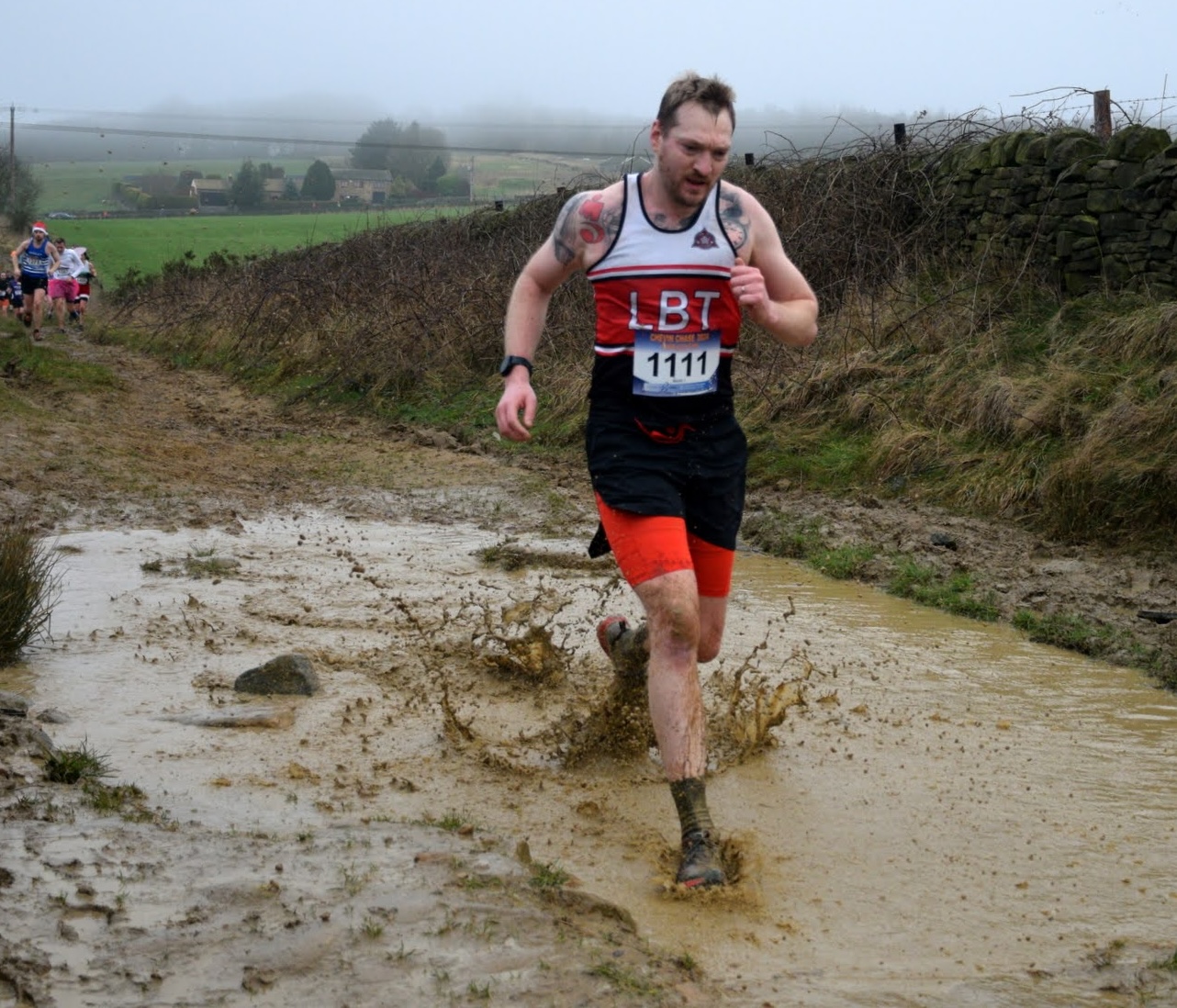
-
Base fitness. Simply the fact that I can turn up the volume for four weeks and race pretty much anything up to 70.3 distance. I want to be healthy, I enjoy keeping fit, and I enjoy the look on the Dr’s face when they take my HR and call for a second opinion because my RHR is too low!
-
And this is maybe the biggest one, and anyone that says different is probably lying – I love telling people I do Ironman. Because I’m extremely proud of what I have achieved.
Translating This to Business: The Entrepreneurial Triathlon
What does any of this have to do with the world of scaling businesses and Technology Leadership and why am I waffling about it on LinkedIn? Far more than you might think! My journey through long-distance triathlon, with all its physical and mental demands, is a powerful metaphor for the challenges and triumphs we face in the business world, especially when guiding a company through rapid growth or technological transformation.
Resilience: The Core of Sustainable Growth
Resilience is paramount for both athletes and businesses. Just as a personal low point can lead to the discovery of mental fortitude required to complete an Ironman, businesses, particularly high-growth ones, face their own moments of extreme pressure and uncertainty.
Navigating Setbacks with Strategic Resolve
Every scaling company encounters unexpected obstacles – a market shift, a key talent departure, a product launch delay, or an unforeseen technical hurdle. The experience of being knocked off a bike and getting back on to finish, mirrors the unwavering commitment needed to guide a business through tough times. As a CTO, the role involves helping leadership teams not just react to problems, but proactively diagnose root causes, implement corrective actions, and build robust systems that prevent recurrence. It’s about taking the hit, assessing the damage, and finding the will to push forward, learning from the experience rather than being defeated by it.
Building Psychological Safety and Adaptive Teams
Training breaks down muscle fibers to grow stronger, and in business, this translates to embracing challenges and even failures as opportunities for growth. As a leader, the aim is to foster environments where teams feel safe to experiment, make mistakes, and learn quickly. This psychological safety is the bedrock for innovation and adaptability, allowing teams to become more resilient and effective with each challenge they overcome. It’s about turning a “crash” into a crucial lesson that strengthens the entire organisation, creating a culture where teams are not just resilient, but antifragile – growing stronger from disorder. The focus is on transparent communication, blameless post-mortems, and a continuous improvement mindset, akin to reviewing race execution to learn and improve for the next one.
Stretching the Comfort Zone: Fueling Innovation and Competitive Advantage
My decision to sign up for an Ironman without being able to swim, or tackling two full distances within three weeks, speaks to a fundamental principle that directly applies to strategic technology leadership:
Embracing Ambitious Goals & The AI Frontier: High-growth companies can’t afford to play it safe. Achieving sustainable competitive advantage often requires stepping into the unknown. As a CTO, I can help define and execute ambitious technology roadmaps – whether that’s exploring new markets, re-platforming legacy systems, or adopting cutting-edge AI. This is where our AI Advisory Services truly come into play: guiding businesses to implement “AI Forward” strategies that aren’t just about buzzwords, but about real, human-AI collaboration for a tangible competitive edge. It’s about having the conviction to invest in innovation, even when it feels like “swimming with sharks,” knowing that pushing boundaries is where true differentiation emerges.
Calculated Risk-Taking for Growth Acceleration: Signing up for a sea swim in rough conditions isn’t reckless; it’s about assessing risks and preparing meticulously. In business, this means evaluating new technologies, market opportunities, and strategic partnerships with a clear understanding of potential upsides and downsides. It’s about challenging the status quo, being comfortable with ambiguity, and guiding your team to develop solutions that might initially seem daunting but ultimately unlock significant value. We help clients de-risk innovation through phased rollouts, proof-of-concept initiatives, and robust technical due diligence, accelerating their growth while managing exposure.
The Power of the Mind: Driving Performance and Unlocking Potential
My perspective on Ironman racing being 40% fuel, 40% mental strength, and 20% fitness, strongly resonates with the dynamics of leading a technology organisation.
Strategic Vision, Not Just Technical Prowess: Just as mental strength is paramount in a race, strategic leadership and a clear vision are critical for business success. Technical expertise (fitness) is essential, but without a compelling “Why” (mental strength) and the right resources (fuel), even the most talented teams can falter. As a CTO, I work with leadership teams to align technology initiatives directly with commercial goals, ensuring that every effort contributes to the “finish line” of business growth. It’s about building the right tech, for the right reasons, at the right time, always with the commercial “True North” in sight.
Managing the “Corporate Chimp”: And just like my internal dialogue with Barry, every business faces its own “chimp moments” – moments of fear, panic, irrational resistance to change, or a desire to take the easy path. My role involves helping leadership teams and their organisations to recognise and manage these reactions. We learn to ‘have a chat with Barry,’ addressing the emotional and psychological barriers that can hinder progress. We start small, get buy-in and build momentum. We provide reassurance by showing people small tangible wins. By understanding these dynamics, we build a more rational, resilient, and focused approach to strategy and execution, ensuring the logical, long-term objectives prevail over short-term discomfort. This cultivation of mental strength and self-awareness is critical for sustained performance and navigating complex decisions.
Unlocking Team Potential and Fostering Leadership: That moment when your body says “no more,” but you find another gear when you see the finish line? That’s the human spirit in action. I believe the same applies to teams. People are capable of far more than they often realise. As a CTO, I focus on empowering teams, fostering a growth mindset, and cultivating leaders who can tap into their collective potential. It’s about building a culture where challenges are met with creativity and determination, pushing past perceived limitations to achieve extraordinary results. We build this through structured goal setting, continuous feedback, mentorship, and celebrating the “little wins” that compound into significant achievements, ensuring your team isn’t just executing, but truly innovating.
Base Fitness & The Pride of Achievement: Operational Excellence and Visible Impact
My desire for “base fitness” and the satisfaction of telling people I do Ironman also have direct business parallels:
Operational Excellence and Business Agility: Being able to “turn up the volume” and race a 70.3 at short notice speaks to operational readiness and efficiency. For a scaling business, this means having robust processes, a scalable technology stack, and an agile team that can rapidly adapt to new demands or seize emerging opportunities. My role is to ensure your technology operations are lean, efficient, and ready to support rapid scaling, providing that “base fitness” for your business to confidently take on new challenges. This includes everything from optimising development workflows and enhancing cybersecurity postures to building resilient infrastructure that can handle significant growth spikes without breaking a sweat.
Commercial Acumen and Demonstrating Tangible ROI: Let’s be honest, the pride in achieving something difficult is a powerful motivator. In business, this translates to delivering tangible, high-impact results that everyone can see and celebrate. As a CTO, I’m focused on projects that move the needle – whether that’s improving unit economics, accelerating time-to-market, de-risking critical initiatives, or unlocking new revenue streams through intelligent AI integration. We don’t just build technology; we build commercial value. It’s about clearly demonstrating the Return on Investment for every strategic technology decision and proudly articulating that success, both internally and to your investors. This ensures that technology is always seen as a profit centre, not just a cost.
The Human-AI Collaboration: My Personal Innovation Journey
Beyond the physical and mental parallels, my triathlon training in the last year has also been a real world use case for my AI Advisory Services. Through all my years of triathlon, I had always relied on various coaching offerings. In the last few years, I worked with a 1-2-1 coach, and before that, I used a more general ‘cookie-cutter’ plan built by a coach based on my race schedule.
Three things really stood out to me:
- Triathlon is an individual sport, despite being brought together by incredible communities of people, whether that’s Facebook groups, local clubs, or WhatsApp.
- Every athlete’s body, schedule, and goals are unique.
- It is an extremely expensive sport, and coaching is a huge cost. With 1-2-1 coaching, I was spending north of £3,000 per year on the coach alone. In my experience, 1-2-1 coaching was never really truly ‘1-2-1’. If a coach wanted to make a living, it physically couldn’t be, as the time spent analysing and adjusting plans per athlete would demand 5-10 hours a week. I do know amateur athletes who’ve had great experiences with 1-2-1 coaching, but I assume the coaches are making a lifestyle choice, as the economies don’t quite work to make a good living from that level of engagement.
This led me to an exciting personal experiment: the DIY AI plan. After years of paying for coaching, I decided to take a different approach. I realised the power of AI as an incredibly potent co-pilot, not a replacement for human expertise. Alongside my own foundational knowledge in triathlon, training principles, and my body’s responses, I began to build and modify my training plan using a custom-built AI agent. Through trial and error, guided by my direct feedback and adaptation, I have executed my own highly personalised training. The results speak for themselves: I successfully completed Challenge Roth, and crucially, I achieved a long sought-after Personal Best (PB) at the 70.3 distance, finally going under 5 hours in May this year – a goal that had eluded me for years despite significant investment in traditional coaching.
This wasn’t about the AI replacing the coach; it was about the AI augmenting my ability to act as my own coach, leveraging data and rapid iteration to achieve optimal results. This personal journey directly informs my professional approach to AI Advisory Services. It proves that the most powerful “AI Forward” strategies aren’t just about deploying technology; they are about intelligent human-AI collaboration. It’s about leveraging AI to provide hyper-personalisation, reduce costs, enhance efficiency, and unlock new capabilities – just as it did for my training. I help businesses understand how to integrate AI to empower their teams, provide tailored solutions, and create sustainable competitive advantage, without needing a full-time, prohibitive investment.
If you have stayed until the end, thank you, please feel free to react, comment and share. And wish me luck for Leeds!